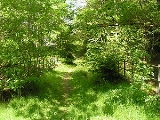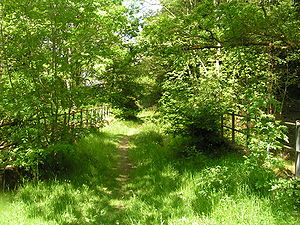
Invergarry and Fort Augustus Railway
Encyclopedia
The Invergarry and Fort Augustus Railway was a branch-line railway built in Scotland
, and served by the Highland Railway
, the North British Railway
and later the London & North Eastern Railway
, Loch Oich
and Loch Ness
form this gap). Either side was served by a railway, but there was no rail service in this void.
to Fort Augustus
, via Invergarry
.
The Invergarry and Fort Augustus Railway company ran out of money; and from 22 July 1903 the Highland Railway
was authorised to operate the line for ten years at a cost of £4,000 per annum. The Highland Railway pulled out on 1 May 1907 and the North British Railway
operated the line until 31 October 1911, when it was closed down. The line was reopened on 1 August 1913; and the North British Railway bought the line in August 1914.
including a platform at a RNAD in Fort Augustus).

. Video 125 made a video documentary about the line, using the sub-heading: The line that should have never been built.
Scotland
Scotland is a country that is part of the United Kingdom. Occupying the northern third of the island of Great Britain, it shares a border with England to the south and is bounded by the North Sea to the east, the Atlantic Ocean to the north and west, and the North Channel and Irish Sea to the...
, and served by the Highland Railway
Highland Railway
The Highland Railway was one of the smaller British railways before the Railways Act 1921; it operated north of Perth railway station in Scotland and served the farthest north of Britain...
, the North British Railway
North British Railway
The North British Railway was a Scottish railway company that was absorbed into the London and North Eastern Railway at the Grouping in 1923.-History:...
and later the London & North Eastern Railway
Beginnings
The Invergarry line was originally set out to bridge the gap between a stretch of land known as "The Three Lochs" (as Loch LochyLoch Lochy
Loch Lochy is a large freshwater loch in Lochaber, Highland, Scotland. With a mean depth of , it is the third deepest loch of Scotland.-Geography:...
, Loch Oich
Loch Oich
Loch Oich is a freshwater loch in the Highlands of Scotland which forms part of the Caledonian Canal, of which it is the highest point. This narrow loch lies between Loch Ness and Loch Lochy in the Great Glen...
and Loch Ness
Loch Ness
Loch Ness is a large, deep, freshwater loch in the Scottish Highlands extending for approximately southwest of Inverness. Its surface is above sea level. Loch Ness is best known for the alleged sightings of the cryptozoological Loch Ness Monster, also known affectionately as "Nessie"...
form this gap). Either side was served by a railway, but there was no rail service in this void.
Construction, opening and change of ownership
The line was constructed from Spean BridgeSpean Bridge
Spean Bridge is a village, in the Highland region of Scotland.The village takes its name from the Highbridge over the River Spean on General Wade's military road between Fort William and Fort Augustus, and not from Telford's bridge of 1819 which carries the A82 over the river at the heart of the...
to Fort Augustus
Fort Augustus
Fort Augustus is a settlement in the Scottish Highlands, at the south west end of Loch Ness. The village has a population of around 646 ; its economy is heavily reliant on tourism....
, via Invergarry
Invergarry
Invergarry is a village in the Highlands of Scotland. It is in the Great Glen, near where the River Garry flows into Loch Oich.Near the centre of the village is the junction between the A82 road and the A87 road which branches off to the west towards Skye.The ruined Invergarry Castle is situated...
.
The Invergarry and Fort Augustus Railway company ran out of money; and from 22 July 1903 the Highland Railway
Highland Railway
The Highland Railway was one of the smaller British railways before the Railways Act 1921; it operated north of Perth railway station in Scotland and served the farthest north of Britain...
was authorised to operate the line for ten years at a cost of £4,000 per annum. The Highland Railway pulled out on 1 May 1907 and the North British Railway
North British Railway
The North British Railway was a Scottish railway company that was absorbed into the London and North Eastern Railway at the Grouping in 1923.-History:...
operated the line until 31 October 1911, when it was closed down. The line was reopened on 1 August 1913; and the North British Railway bought the line in August 1914.
Closures
After the First World War, the North British Railway was amalgamated into the London & North Eastern Railway, who used it largely for freight purposes rather than passenger traffic. The line closed to passenger traffic on 1 December 1933 and closed to goods on 1 January 1947 (it was used for goods during World War IIWorld War II
World War II, or the Second World War , was a global conflict lasting from 1939 to 1945, involving most of the world's nations—including all of the great powers—eventually forming two opposing military alliances: the Allies and the Axis...
including a platform at a RNAD in Fort Augustus).

Today
Some of the line today has been built over by roads and holiday parks, although it mostly survives in a reasonably good, if overgrown, condition. The many bridges and single tunnel are in particularly good condition, and the section along Loch Oich has been incorporated into the Great Glen WayGreat Glen Way
The Great Glen Way is a long distance footpath in Scotland. It follows the Great Glen, running from Fort William in the west to Inverness in the east, covering 73 miles . It was opened in 2002 and is one of Scotland's four long distance routes. The Great Glen Way is generally walked from west to...
. Video 125 made a video documentary about the line, using the sub-heading: The line that should have never been built.
External links
- Route on OpenStreetMapOpenStreetMapOpenStreetMap is a collaborative project to create a free editable map of the world. Two major driving forces behind the establishment and growth of OSM have been restrictions on use or availability of map information across much of the world and the advent of inexpensive portable GPS devices.The...

